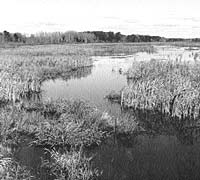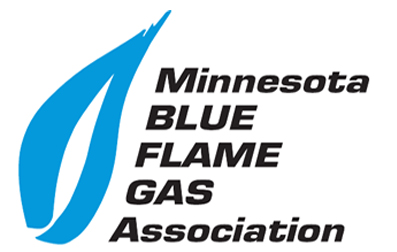 Finding answers to pollution problems is a worldwide concern. If we are to reduce global warming and emission of harmful pollutants into the air and water, we must begin to choose cleaner, more efficient energy sources.
Finding answers to pollution problems is a worldwide concern. If we are to reduce global warming and emission of harmful pollutants into the air and water, we must begin to choose cleaner, more efficient energy sources.
Natural gas can provide an answer
Fossil or hydrocarbon fuels include natural gas, coal and oil derived from dead plants and animals that decomposed millions of years ago; they provide 90 percent of our energy needs. Of the three, natural gas is safest for the environment. Fossil fuels release their energy through combustion, a process that can produce a variety of pollutants. Among these pollutants are sulfur oxides, nitrogen oxides, reactive hydrocarbons, carbon monoxide and solid particles called particulates. The amount of pollutants released ranges from almost nothing with natural gas, to substantial amounts with coal.
Acid rain. Probably the most familiar form of air pollution, acid rain is caused when sulfur dioxide and nitrogen oxides enter the atmosphere and return to earth with rain, fog or snow.
The “greenhouse effect.” This occurs because fossil fuel emissions, particularly carbon dioxide (C02) from vehicle exhaust, remain in the atmosphere, creating a heat trap that alters normal wind and precipitation patterns. Many scientists predict this syndrome will cause temperatures in the United States to rise 3 to 8 degrees Fahrenheit by the year 2050.
Carbon monoxide and hydrocarbons. These pollutants result from incomplete burning of fuel; the fuel still has energy that could be released by further burning. Many unburned hydrocarbons react with other pollutants in sunlight to form what is known as “smog” which also contributes to the greenhouse effect. Natural gas is a non-reactive hydrocarbon; it does not react with sunlight to form smog as coal and oil do.
Nitrogen oxides. Like hydrocarbons, nitrogen oxides (NOx) are partially responsible for formation of smog and contribute to acid rain and the greenhouse effect. Nitrogen oxides are produced whenever heat is generated by burning fuels in the presence of air. Temperatures reached by the burning fuel and rates of cooling determine the amount of nitrogen oxides formed. In most applications, burning natural gas results in significantly less nitrogen oxides emissions than caused by equivalent burning of coal or oil (see Figure 1).
Sulfur oxides and particulates. Particulates are particles like soot, tiny enough to become airborne. Along with sulfur oxides, they are produced directly from burning fuel. They change chemically in the atmosphere and return to earth as acid rain or in dry acid deposits.
| Fig 1. Comparison of Air Pollution Contributions of Standard Fossil Fuels (pounds of emissions per billion Btu* | |||
| Gas | Oil | Coal | |
| Carbon monoxide | 17-20 | 40 | 44-48 |
| Hydrocarbons | 1-8 | 7 | 13-44 |
| Nitrogen oxides | 80-700 | 130-760 | 670-2,240 |
| Sulfur oxides | 0.6 | 830-940 | 660-4,390 |
| Particulates | 5-15 | 140-720 | 60-9,440 |
| Based on information provided by the Environmental Protection Agency, the U.S. Department of Energy and Hittman Associates, Inc. | |||
| * A Btu-British thermal unit–is the quantity of heat that must be added to one pound of water to raise its temperature one degree Fahrenheit, from 58.5 to 59.5 degrees, under standard pressure of 30 inches of mercury. | |||
| Natural gas production poses the least risk to the environment |
Of the three fossil fuels, natural gas production is least damaging to the environment. It involves minimal disturbance of the surrounding area; once drilling into the earth is completed, and the equipment removed, the environment quickly returns to its original state.
Transporting natural gas from offshore drilling is safer than transporting oil. In recent years, oil spills around the world have been responsible for massive damage to wildlife and contamination of the environment.
| Natural gas: a clean source of energy |
Electricity Generation
As populations and industries grow, our need for electricity grows, too. Generation of electricity is a major source of pollution, and there’s little agreement on which energy to use to help protect the environment; cleaner forms of energy are often limited in ways that make them unavailable for power generation:
- Hydropower is limited by geography.
- Nuclear energy’s environmental problems continue to be debated.
- The sun, wind and sea are attractive potential energy sources but none is broadly available yet.
Coal is one of America’s most abundant resources and is commonly burned to generate electricity. However, it produces the most pollution when burned, emitting large quantities of sulfur dioxide, particulates and nitrogen oxides (see Fig. 1).
In a trend that may be catching on nationwide, utilities are switching from coal and fuel oil to natural gas for generating electricity. The Energy Information Administration predicts natural gas-fired power generation will more than double by the year 2000, surpassing nuclear energy and becoming the second-largest utility energy source, next to coal.
Natural gas can be combined with other fuels to make them cleaner
Burning natural gas with other fuels such as coal or oil, reduces pollution and improves efficiency in many applications.
- Co-firing: This process of simultaneously burning natural gas with coal in the same boiler reduces emissions and improves operational performance. Co-firing reduces emissions of sulfur dioxide, nitrogen oxides, particulates, and other pollutants, and allows fewer sludge deposits to accumulate on equipment, so equipment runs more efficiently and lasts longer.
- Reburning: Natural gas replaces some of the coal in the coal-burning boiler in the reburning process. Gas is injected into the upper part of the furnace, creating a zone in which nitrogen oxides are changed into harmless molecular nitrogen. Reburning, according to the American Gas Association, could reduce nitrogen oxides emissions by 50 to 60 percent.
- Cogeneration: Natural gas is used to simultaneously produce electricity and heat. Heat produced during the generation of electricity is recovered and used to fuel industrial processes, provide space heating, and create hot water and steam.Overall efficiencies of natural gas cogeneration systems are as high as 80 percent and, because they burn less fuel, they generate fewer pollutants. Natural gas used to generate electricity emits the least carbon dioxide per unit of electricity delivered. Burning oil emits 50 percent more carbon dioxide than gas; burning coal emits 90 percent more carbon dioxide than burning natural gas.
- Combined-cycle generation: Gas or gas-coal turbines drive generators to produce electricity in this process. Heat captured from the process is used to create steam which drives a second turbine, producing additional electricity. Combined-cycle generation produces the same amount of electricity as a conventional plant, using only about 80 percent of the fuel. It also emits less than 0.3 percent of the sulfur dioxide and particulates, and only 50 percent of the nitrogen oxides of a conventional coal-fired plant.
| Natural gas: the low-cost cooling answer to environmental concerns |
As electric rates rise and environmental concerns grow, natural gas is becoming increasingly attractive for cooling. There has recently been a dramatic increase nationwide in the number and types of facilities specifying natural gas cooling.
Depending on the technology, several natural gas cooling units use little or no chlorofluorocarbons (CFCs), the major environmental offender in most refrigeration and cooling technology. While gas-fueled cooling units may cost more initially than their electric counterparts, lower operating costs usually swing the balance in favor of natural gas. Use of gas cooling will also help reduce peak electric loads.
There are three natural gas cooling technologies
- Natural gas absorption: Water, the refrigerant in an absorption system, passes through an expansion device to the evaporator where it vaporizes as it removes heat from the conditioned space. Instead of a compressor, the gaseous refrigerant is then absorbed in a concentrated salt solution. The solution from the refrigerant/absorbent combination is then heated by a natural gas burner, vaporizing the refrigerant. The vaporized refrigerant moves to the condenser where the heat from the conditioned space, plus the heat from the burner is released to the outdoors. The absorbent then returns to the absorber and repeats the cooling cycle.Absorption units are most often used for commercial or industrial air conditioning applications.
- Natural gas desiccant* dehumidification and cooling:
Air that is heavy with moisture is passed through desiccant material which absorbs the moisture. The dry air is then returned to the space where it is more efficiently cooled. A natural gas heat source then regenerates the desiccant so it is again able to absorb moisture. This technology is quickly becoming a major factor in reducing pollution.Desiccant dehumidification and cooling is used in supermarkets, office buildings, restaurants, nursing homes, ice arenas and in manufacturing processes. Desiccant dehumidification removes moisture from duct work where bioaerosols–germs and bacteria–tend to multiply. Removing moisture from the duct work reduces the risk of unhealthy air and generally improves the quality of air in buildings.* Desiccant: Materials which have a high affinity for water. Desiccants absorb moisture from the air in the form of water vapor and require heat to desorb (dry out). - Natural gas engine-driven:
Water chillers: These units are used in commercial and industrial settings to provide air conditioning and cooling and refrigeration for industrial processes. Instead of an electric motor, they use a very efficient natural gas engine to drive the cooling process. Heat from the engine can then be used to heat water, help condition space or regenerate a desiccant.Heat pumps: Heat pumps both heat and cool by transfering energy from one source to another. For heating, most heat pumps designed for homes use outside air as the heat source along with heat from operation of the engine. Natural gas heat pumps operate in the same way as electric heat pumps; they remove heat from the home in summer and provide heat in winter.
Many companies have been active in developing, testing and promoting these natural gas cooling technologies. Several test units have been installed in Minnesota with good results.
| Natural gas is a good choice for vehicles |
 Despite substantial improvements in engine technologies, fuel efficiency and highway planning in recent years, motor vehicles still contribute up to 62 percent of the carbon monoxide (CO) found nationwide, as well as 26 percent of volatile organic compounds (VOCs) and 32 percent of nitrogen oxides (NOx), major contributors to ozone depletion.* With numbers of vehicles and emissions problems expected to increase into the next century, policymakers continue to place a high priority on controlling vehicle emissions. Using natural gas as a vehicle fuel is among their solutions.
Despite substantial improvements in engine technologies, fuel efficiency and highway planning in recent years, motor vehicles still contribute up to 62 percent of the carbon monoxide (CO) found nationwide, as well as 26 percent of volatile organic compounds (VOCs) and 32 percent of nitrogen oxides (NOx), major contributors to ozone depletion.* With numbers of vehicles and emissions problems expected to increase into the next century, policymakers continue to place a high priority on controlling vehicle emissions. Using natural gas as a vehicle fuel is among their solutions.
* DOE, National Energy Policy Plan 20 (July, 1995).
Natural gas vehicles (NGVs) are safer for the environment
When used as a vehicle fuel, natural gas provides many environmental advantages over gasoline or diesel fuel. Vehicles that operate on compressed natural gas (CNG) emit far fewer emissions than the accepted standards for many pollutants, generate no lead compounds to contaminate air and soil and produce 16 percent fewer greenhouse gas emissions than gasoline- powered vehicles. NGVs meet the stringent requirements of the State of California’s ultra-low emission vehicle (ULEV) standards. Natural gas also reduces our nation’s dependence on foreign oil imports, another major advantage to using it as a vehicle fuel.
| Clean-burning compressed natural gas fuels business fleets |
Several area businesses have discovered the environmental and economic advantages of using clean-burning natural gas to fuel their fleet vehicles. In addition to local utility companies, business users include Aveda Corp., Minnesota Viking Food Service, the U.S. Postal Service, the River City Trolley (operated by the Minneapolis Convention & Visitors Bureau) and many more. These companies refuel using either their own on-site refueling compressors or public refueling stations in the Minneapolis area.
Smaller home compressors allow NGV owners to refuel with natural gas from the same gas line that serves their furnaces and home appliances.
| Natural gas supply is strong |
The United States has plentiful supplies of natural gas at competitive prices. Ninety-three percent of the gas used in the United States is produced in this country; most of the rest comes from Canada. It is delivered to homes, businesses and factories through an efficient million-plus mile underground pipeline system.
A recent U.S. Department of Energy report on domestic natural gas supplies puts potential natural gas supplies at 1,059 Trillion Cubic Feet (TCF), enough to meet our natural gas energy needs for 60 years.
In addition to conventional sources, unconventional sources currently producing natural gas include Eastern Devonian shale,* Western tight sands,** coal seam methane, brine deposits under the Gulf of Mexico, and enhanced gas recovery. Development of new gas technology will help convert these vast supplies from unconventional to conventional, extending the natural gas supply even further into the future.
* Eastern Devonian shale: geological formations, typically hundreds of feet thick, that underlie much of the Appalachian Basin. Contains quantities of natural gas, but usually lacks sufficient natural permeability for ordinary production.
** Tight sands: Gas-bearing geologic strata that holds gas too tightly for conventional extraction processes to bring it to the surface at economical rates, without special incentives.
| We use natural gas in the form we find it |
Natural gas doesn’t have to be converted to a different form before being used
Relatively small amounts of pollutants present in natural gas when it comes from the ground are virtually all removed before it enters the pipeline. This eliminates the need for pollution control equipment at the end-use site.
Electricity, on the other hand, requires a great deal of energy to create and process. Only about 28 percent of the energy burned to create electricity actually becomes electricity. This means that of every 100,000 Btus of coal, oil or natural gas burned to generate electricity, only 28,000 Btus of electricity reach consumers.
The natural gas delivery system, on the other hand, is 89 percent efficient; of every 100,000 Btus of natural gas extracted from a gas well, 89,000 Btus of heat reach consumers.
| Natural gas helps protect our environment for tomorrow |
As inheritors of the earth’s environment, we are responsible for protecting it for future generations.
Using natural gas to heat and cool our homes, heat our water, cook our meals, dry our clothes and operate our vehicles, and in commercial and industrial applications, can do more than reduce energy costs–it can help us protect the environment. Our immediate challenges are to:
- Choose energy wisely and use it in ways that do the least damage to the earth’s ecosystems.
- Make the most efficient use of energy through conservation and development of more efficient equipment.
- Discover new energy sources and technologies to provide energy for the future.

